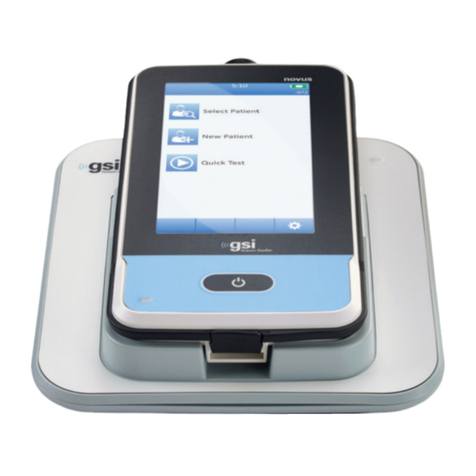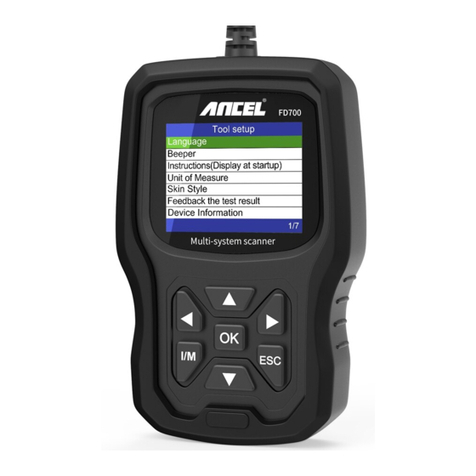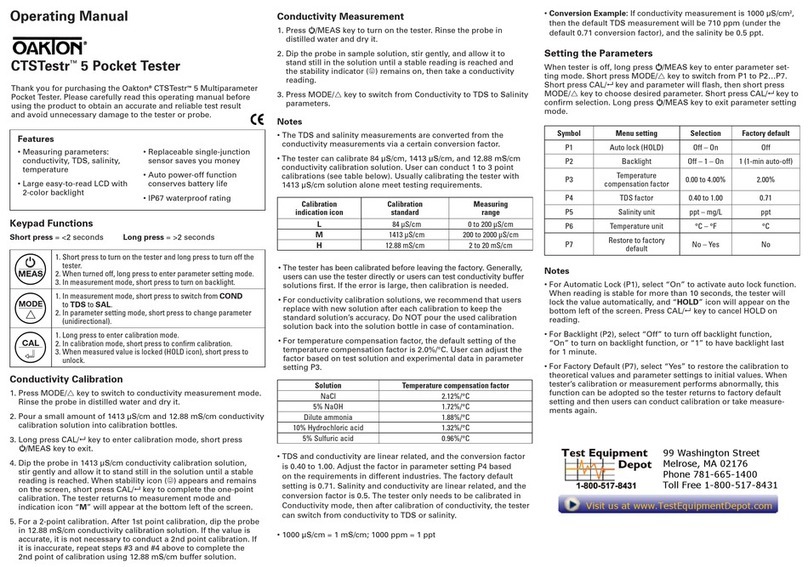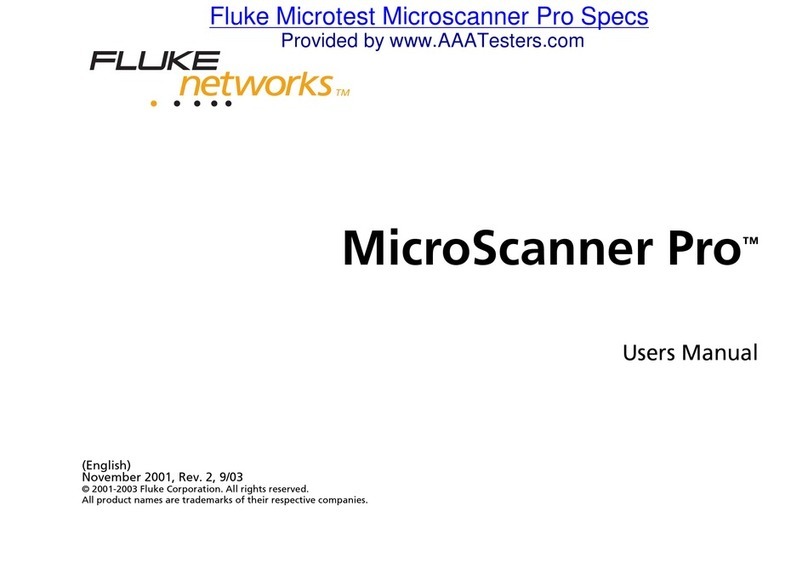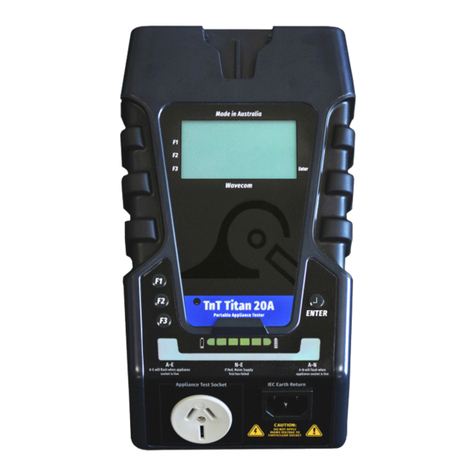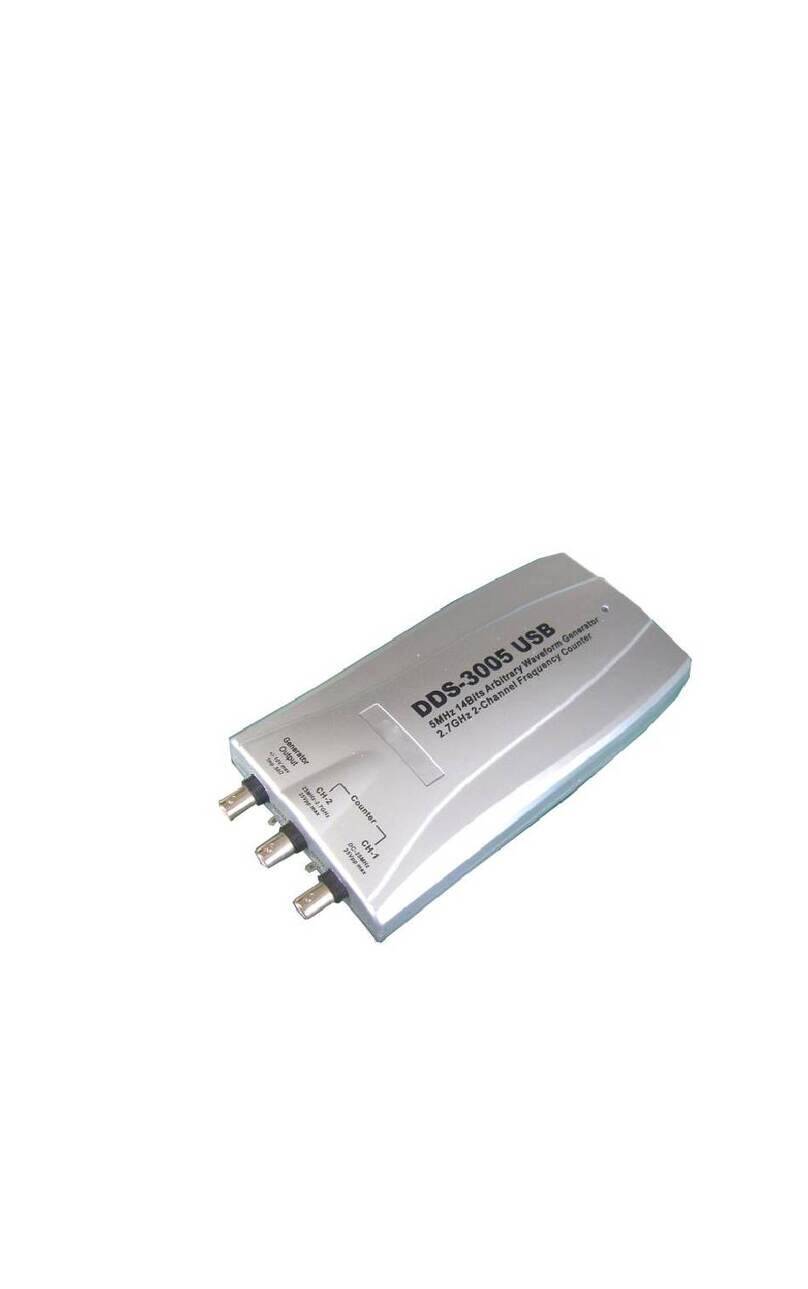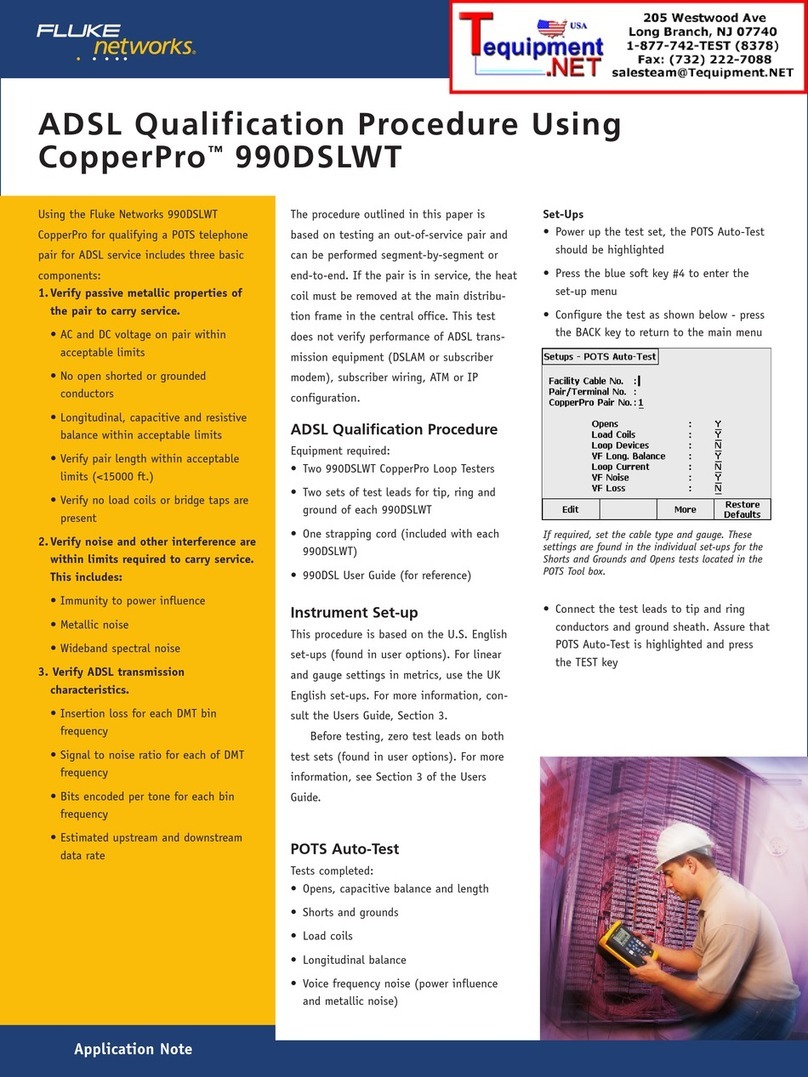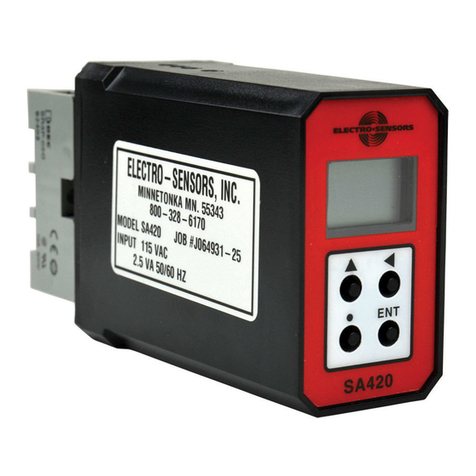Grason-Stadler GSI Corti User manual

CORTI
DPOAE
TEOAE
DEVICE
USER MANUAL

Title: GSI Corti™ User Manual
EC REP
Grason-Stadler
c/o DGS Diagnostics A/S
Audiometer Alle 1,
5500 Middelfart
Denmark
Copyright © 2020 Grason-Stadler. All rights reserved. No part of this publication may
be reproduced or transmitted in any form or by any means without the prior written
permission of GSI. The information in this publication is proprietary to GSI.
Compliance
The CE 0123 mark identifies compliance with the Medical Device Directive 93/42/EEC.
Grason-Stadler is an ISO 13485 certified corporation.
0123
Caution: US Federal law restricts this device to sale by or on the order of a physician or licensed
hearing care professional.

D-0103241Rev H Page 1 of 76
TABLE OF CONTENTS
Table of Contents .....................................................................................................................1
Preface.......................................................................................................................................5
Manual Conventions.............................................................................................................5
Regulatory Symbols ..............................................................................................................6
Warnings and Cautions............................................................................................................9
Important Safety Instructions..............................................................................................9
Safety Precautions ................................................................................................................9
Charging...............................................................................................................................11
Electric Shock Hazard .........................................................................................................11
Explosion .............................................................................................................................11
Battery .................................................................................................................................11
Environmental Factors .......................................................................................................11
Calibration ...........................................................................................................................11
Introduction ............................................................................................................................12
Intended Use.......................................................................................................................12
Indications For Use .............................................................................................................12
How Does the Corti Device Work?.....................................................................................13
What are DPOAEs?..............................................................................................................13
What Are TEOAEs? ..............................................................................................................14
What Do Otoacoustic Emission Results Tell Us? ..............................................................14
What Frequency Range of Hearing is Estimated? ............................................................14
How are the Results Stored and Reported?......................................................................14
Sensitivity and Specificity ...................................................................................................15
Setup........................................................................................................................................16
Unpacking the System........................................................................................................16
Optional Accessories ..........................................................................................................16
Cradle (Optional) .............................................................................................................16
Battery Charging .................................................................................................................17
Installing the Probe.............................................................................................................18
Attaching Probe Tube .........................................................................................................18
Attaching Eartips.................................................................................................................18

D-0103241Rev H Page 2 of 76
Probe Holder .......................................................................................................................19
Operating Instructions ...........................................................................................................20
Preparing the Patient for Testing ......................................................................................20
Turning On the Instrument................................................................................................20
Control Panel.......................................................................................................................20
Main Menu ..........................................................................................................................21
Selecting the Test Protocol.................................................................................................21
Starting a Test .....................................................................................................................22
AutoStart Probe Check .......................................................................................................22
Test Phase ...........................................................................................................................23
SNR Bar Graph View ...........................................................................................................23
Value Graph View................................................................................................................24
Viewing Results ...................................................................................................................24
Viewing DPOAE Results with Normative Data ..................................................................26
Test Technique ....................................................................................................................27
Noise Sources..................................................................................................................27
Turning Off the Instrument................................................................................................27
Managing Results................................................................................................................28
Saving Results......................................................................................................................28
Deleting Results ..................................................................................................................29
Printing to a Thermal Printer .............................................................................................30
Connecting to the Corti Data Manager .............................................................................31
Understanding Printed Results..........................................................................................31
Rounding Results.............................................................................................................32
Clock Settings ......................................................................................................................33
Accessing the Clock Menu ..............................................................................................33
Changing the Date/Time.................................................................................................33
Instrument Settings................................................................................................................34
Wireless Device Pairing ......................................................................................................34
Clearing Test Results ..........................................................................................................35
Auto Shutdown Time ..........................................................................................................35
Save Mode/Storing Test Results ........................................................................................35
Minimum Amplitude Value ................................................................................................36

D-0103241Rev H Page 3 of 76
Clock Mode..........................................................................................................................37
Graph Style ..........................................................................................................................37
Norms ..................................................................................................................................37
Reverse Frequency..............................................................................................................38
Auto Stop .............................................................................................................................38
Language .............................................................................................................................38
Reset to Default...................................................................................................................38
Advanced Options ..................................................................................................................39
DPOAE Diagnostic Unit.......................................................................................................39
Instructions for Customizing a Test Protocol................................................................39
Selecting the Level of Primary Tones.............................................................................40
Setting the Averaging Time.............................................................................................40
Setting the PASS SNR Level.............................................................................................40
Setting the Number of Frequencies for PASS ...............................................................41
Reset Protocol..................................................................................................................41
Save Protocol...................................................................................................................42
TEOAE Diagnostic Unit........................................................................................................42
Instructions for Customizing a Test Protocol................................................................42
Selecting the Averaging Time .........................................................................................43
Setting the PASS SNR Level.............................................................................................43
Setting the Number of Frequencies for PASS ...............................................................44
Reset Protocol..................................................................................................................44
Save Protocol...................................................................................................................44
Cleaning and Maintenance ....................................................................................................45
Cleaning and Disinfection ..................................................................................................45
Maintenance........................................................................................................................46
Probe tube Replacement ...................................................................................................46
Status/Error Messages ...........................................................................................................47
Display Messages:...............................................................................................................47
Indicator LEDs (lights) .........................................................................................................48
Troubleshooting .....................................................................................................................49
Appendix A: Specifications.....................................................................................................52
PROBE SPECIFICATIONS .....................................................................................................52

D-0103241Rev H Page 4 of 76
INSTRUMENT SPECIFICATIONS ..........................................................................................52
POWER SUPPLY SPECIFICATIONS (use only approved power supply)............................53
ENVIRONMENTAL REQUIREMENTS ...................................................................................53
Appendix B: Flowcharts..........................................................................................................54
Measurement......................................................................................................................54
Setup Menus .......................................................................................................................55
Appendix C: Test Sequence ...................................................................................................57
DPOAE..................................................................................................................................57
TEOAE...................................................................................................................................57
Comment about Variations in the SNR Estimate .............................................................58
Appendix D: Pass/Refer Criteria ............................................................................................59
DPOAE..................................................................................................................................59
TEOAE...................................................................................................................................60
Appendix E: Configurations and Test Protocols...................................................................62
Diagnostic Configurations..................................................................................................62
DPOAE Diagnostic Default Protocols.................................................................................63
TEOAE Diagnostic Default Protocols .................................................................................64
GSI Corti Screening Configurations...................................................................................64
DPOAE Screening Default Protocols..................................................................................65
TEOAE Screening Default Protocols ..................................................................................65
Appendix F: Standards Compliance ......................................................................................66
Appendix G: Specification of Input/output Connections.....................................................67
OAE Probe ...........................................................................................................................67
Appendix H: Warranty............................................................................................................68
Appendix I: Recycling and Disposal.......................................................................................69
Appendix J: Electromagnetic Compatibility ..........................................................................70
Electrical Safety, EMC and Associated Standards.............................................................70

D-0103241Rev H Page 5 of 76
PREFACE
This user manual provides information about the GSI Corti OAE instrument. This
manual is intended for technically qualified personnel.
Please note: This User Manual is not intended as a training manual. The reader should
consult standard audiology texts for the theory and application of the tests provided by
this instrument.
This operating manual contains information pertinent to the use of the GSI Corti system
including safety information as well as maintenance and cleaning recommendations.
READ THIS ENTIRE MANUAL BEFORE ATTEMPTING TO USE THE SYSTEM!
MANUAL CONVENTIONS
Throughout this manual, the following meaning of warnings, cautions and notices are
used.
WARNING
The WARNING symbol identifies conditions or practices that may present
danger to the patient and/or user.
CAUTION
The CAUTION Symbol identifies conditions or practices that could result in
damage to the equipment or loss of data.
NOTE: Notes help you identify areas of possible confusion and avoid potential
problems during operation.

D-0103241Rev H Page 6 of 76
REGULATORY SYMBOLS
Symbol
Description
Serial Number
Date of Manufacture
Manufacturer
Caution, Consult Accompanying Documents
Return to Authorized Representative, Special
Disposal Required
Reference Number
B Patient Applied Part According to IEC60601-1
Consult Operating Instructions
Keep Dry
Transport and Storage Temperature range
Logo
EC REP
EU Authorized Representative

D-0103241Rev H Page 7 of 76
Symbol
Description
Nonionizing electromagnetic radiation
Global Trade Item Number
For Use by or on the order of a licensed medical
professional.
Recycle Lithium ion battery
Recycle - Taiwan
China RoHs
Direct Current (DC)
Only those products bearing the UL Classification
Mark for the U.S. and Canada should be considered
as being covered by UL's Classification and Follow-
Up Service and meeting the appropriate U.S. and
Canadian requirements.
Conforms to European Medical Device Directive
93/42/EEC
FCC 47CFR, Part 15.247 & 15.249 (Wireless)
Consult the operating instructions/directions for
use. A copy of the operating manual is available on
this website: www.grason-stadler.com
A printed copy of the operating instructions can be
ordered from Grason-Stadler for shipment within 7
days; or you can contact your local representative.
E486032

D-0103241Rev H Page 8 of 76
Symbol
Description
Consult the operating instructions/directions for
use. A copy of the operating manual is available on
this website: www.grason-stadler.com
A printed copy of the operating instructions can be
ordered from Grason-Stadler for shipment within 7
days; or you can contact your local representative.
Indicates that the device is a Medical Device
Class II medical equipment

D-0103241Rev H Page 9 of 76
WARNINGS AND CAUTIONS
IMPORTANT SAFETY INSTRUCTIONS
The following safety precautions must be observed always. General safety
precautions must be followed when operating electrical equipment. Failure
to observe these precautions could result in damage to the equipment and
injury to the operator or patient.
The instrument must only be used by hearing health care professional qualified to
perform otoacoustic tests such as an audiologist, otolaryngologist, researcher or a
technician under the direct supervision by the specialist. Users should use their
professional skills when interpreting the results and this should be done in conjunction
with other testing as deemed appropriate given their professional skills. Incorrect use
could lead to wrong results. It is intended for transient use as a screening and
diagnostic tool. However, no surgical or medical procedure should be undertaken
solely based on results obtained from the instrument.
The employer should instruct each employee in the recognition and avoidance of
unsafe conditions and the regulations applicable to his or her work environment to
control or eliminate any hazards or other exposure to illness or injury. It is understood
that safety rules within individual organizations vary. If a conflict exists between the
material contained in this manual and the rules of the organization using this
instrument, the more stringent rules should take precedence.
SAFETY PRECAUTIONS
This product and its components will perform reliably only when operated
and maintained in accordance with the instructions contained in this
manual, accompanying labels, and/or inserts. A defective product should
not be used. Make sure all connections to external accessories are snug
and secured properly. Parts which may be broken or missing or are visibly worn,
distorted, or contaminated should be replaced immediately with clean, genuine
replacement parts manufactured by or available from GSI.
If the system is not functioning properly, do not operate it until all necessary repairs are
made and the unit is tested and calibrated for proper functioning in accordance with
GSI published specifications.
No parts of the equipment can be serviced or maintained while in use with the patient.
Never insert the probe into a patient’s ear canal without a suitable ear tip fitted to the
probe. Use only the recommended disposable ear tips. These are for single use only -
that is, each ear tip is intended to be used once only for a single ear for a single patient.
Do not reuse ear tips as this will pose the risk of ear-to-ear or patient-to-patient cross
infection.

D-0103241Rev H Page 10 of 76
Latex is not used anywhere in the manufacturing process. The base material for the ear
tips is made from silicone rubber.
The device is not intended to be used in environments exposed to fluid spills. No
means is specified for fluid protection (not IP classed). Do not use the device in the
presence of fluid that can contact any of the electronic components or wiring. Should
the user suspect fluids have contacted the system components or accessories, the unit
should not be used until deemed safe by an authorized service technician. Do not
immerse the unit in any fluids. See the Routine Maintenance Section of this manual for
the proper cleaning procedure for the instrument and its accessories and the function
of single-use parts.
Do not drop or otherwise impact this instrument. If the instrument is dropped or
damaged, return it to the manufacturer for repair and/or calibration. Do not use the
instrument if any damage is suspected.
The device is not user repairable. Do not attempt to open, modify, or service the
instrument. No modifications of the equipment are allowed by anyone other than a
qualified GSI representative. Modification of the equipment could be hazardous.
Return the instrument to the manufacturer or distributor for all repair, battery
replacement and servicing requirements. Opening the instrument will void the
warranty.
The Corti product has been verified by an independent laboratory to conform to
international standards for EMC (electromagnetic emissions and immunity). The user is
advised to avoid installation and use of this instrument in proximity with other devices
or equipment that may emit or be susceptible to electromagnetic interference, including
mobile phones. If the instrument is used adjacent to other devices or equipment, the
user is instructed to verify that no disturbance is found in the operation of this or other
equipment in proximity.
Instruments which bear the Underwriters Laboratories, Inc. label should
be interconnected with accessories that have the proper electrical
compatibility and are listed as meeting the requirements of the UL
Medical and Dental Equipment Standard. Connection of accessories not meeting these
requirements may result in electrical leakage currents in excess of those allowed by the
standard and present a potential electrical shock hazard to the person being tested.
This device complies with part 15 of the FCC Rules. Operation is subject to the
condition that this device does not cause harmful interference.

D-0103241Rev H Page 11 of 76
CHARGING
The Corti Otoacoustic Emission Test System should be charged using only
the provided power supply. Injury to personnel or damage to equipment
can result when a three-prong to two-prong adaptor is connected between
the Corti power supply and an AC outlet.
ELECTRIC SHOCK HAZARD
Do not open the case of the Corti Instrument. Refer servicing to qualified
personnel. Do not touch the contacts on the bottom of the instrument and
the patient at the same time. Do not connect the instrument to the patient
and the PC at the same time. In case of emergency, disconnect the
instrument from the supply mains by removing the micro-USB cable from the
connector.
EXPLOSION
This system is not explosion proof.
Do NOT use in the presence of flammable gaseous mixtures. Users should
consider the possibility of explosions or fire when using this device near
flammable anesthetic gases. Do NOT use the system in a highly oxygen-
enriched environment, such as a hyperbaric chamber, oxygen tent, etc.
BATTERY
This instrument contains a rechargeable lithium-ion battery. Batteries may
explode or cause burns, if disassembled, crushed or exposed to fire or high
temperatures. The battery is not user replaceable and must be returned to
an authorized GSI service location for repair.
ENVIRONMENTAL FACTORS
Use and store the instrument indoors only. It is recommended that the
instrument be operated within an ambient temperature range of 15 °C /
59 °F to 35 °C / 95 °F and in relative humidity between 30 % and 90 % (non-
condensing). Transport the instrument and store the instrument in
temperatures between 5 °C / 41 °F to 40 °C / 104 °F.
CALIBRATION
Annual calibration recommended. Have an authorized service technician perform
electrical safety checks on the unit in order to maintain continued compliance to IEC
and UL 60601-1.

D-0103241Rev H Page 12 of 76
INTRODUCTION
The purpose of the Corti test system is to provide rapid measurement and
documentation of Distortion Product Otoacoustic Emissions (DPOAEs) or Transient
Evoked Otoacoustic Emissions (TEOAEs).
INTENDED USE
The GSI Corti is a test instrument that measures otoacoustic emissions in infants,
children, and adults.
INDICATIONS FOR USE
The GSI Corti series is indicated for testing of cochlear function in infants, children and
adults by measuring otoacoustic emissions (OAEs). The OAEs are generated by a series
of clicks that are directed into the ear canal. Otoacoustic emissions are low level audio-
frequency sounds that are produced by the cochlea as part of the normal-hearing
process. Available evidence suggests that otoacoustic emissions are generated by the
cochlea’s outer hair cells and that the presence of OAEs is an indication that the outer
hair cells are viable. Clinical evidence indicates that these emissions normally occur
with normal hearing, or at most, mild hearing loss (usually 30-40 dB HL). The majority
of hearing-impaired individuals will be identified by a simple OAE test.

D-0103241Rev H Page 13 of 76
HOW DOES THE CORTI DEVICE WORK?
The system consists of the
instrument, probe, printer, single-
use eartips replaceable probe tubes
and other accessories. The Corti
instrument contains the hardware
and software for generating the test
stimuli, measuring and displaying
the OAEs, and storing the results
until they are printed. The plastic
housing contains circuit boards that
provide the signal processing and
display the test results. The
instrument also contains a
rechargeable lithium-ion battery to
power the device. The instrument
uses a liquid-crystal display (LCD)
and three light-emitting diodes
(LEDs) to provide a visual display of
test status to the operator. Four
push buttons located on the keypad
of the device allow the user to
control testing and printing, and to
reset test protocols.
The Probe houses the speaker and
microphone which produce test stimuli and measure the sound pressure level (SPL)
present in the sealed ear canal. Interface of the instrument to the ear canal is
accomplished through disposable eartips, which fit onto the probe tube. The disposable
eartips are color coded to facilitate easy selection by size.
WHAT ARE DPOAES?
Distortion Product Otoacoustic Emissions (DPOAEs) are acoustic signals that can be
detected in the ear canal of a person with normal outer hair cell function, after
stimulation of the auditory system with a pair of pure tones at frequencies f1 and f2.
The frequency pairs are presented at a F2/F1 ratio of 1.22. The resulting emission of
interest is the distortion product tone at the frequency 2f1-f2.
The Corti instrument generates a series of test tones, directs them into the ear canal,
and then measures the level of the DPOAE tone generated by the cochlea. By using
different test frequencies, the Corti device provides an estimate of outer hair cell
function over a wide range of frequencies.
User Interface
Buttons
Probe
Micro-USB
Connector
Charge Status
Indicator
Display
Test Status
Indicators

D-0103241Rev H Page 14 of 76
WHAT ARE TEOAES?
Transient Evoked Otoacoustic Emissions (TEOAEs) are acoustic signals that can be
detected in the ear canal of a person with normal outer hair cell function, after
stimulation of the auditory system with a series of wideband clicks.
The Corti instrument generates a series of clicks, directs them into the ear canal, and
then analyzes the spectrum of the returning signal, separating the noise and emission.
By using band pass filters, the Corti device provides an estimate of outer hair cell
function over a wide range of frequencies.
WHAT DO OTOACOUSTIC EMISSION RESULTS TELL US?
The presence of otoacoustic emissions suggests normal outer hair cell function, which
in turn correlates to normal hearing. However, a passing result using this instrument is
not an indication that the full auditory system is normal. Thus, a PASS result should not
be allowed to override other indications that hearing is not normal. A full audiologic
evaluation should be administered if concerns about hearing sensitivity persist. A REFER
test result should not be assumed to be an indicator of a lack of auditory function or the
presence of pathology; however, it should be followed with full audiologic diagnostic
testing and/or medical evaluation as appropriate.
WHAT FREQUENCY RANGE OF HEARING IS ESTIMATED?
DPOAEs: Approximately 1 kHz to 12 kHz (depending on the frequency range selected).
TEOAEs: Roughly 500 Hz to 4 kHz.
HOW ARE THE RESULTS STORED AND REPORTED?
When the Corti is set in its default settings, the instrument will store the results from
one patient (left and right ear) in its non-volatile memory for subsequent printing.
However, the Corti instrument can store up to 500 test results. The results are displayed
via the LCD on the front of the device and are stored in the device’s internal memory.
After testing is completed, results can be printed using the printer and/or exported to a
computer. Test results are stored in the non-volatile memory so the operator can delay
printing until a later time if desired.

D-0103241Rev H Page 15 of 76
SENSITIVITY AND SPECIFICITY
Sensitivity and specificity of this type of device are based on the test characteristics
defined by the user and may vary depending on environmental and operating
conditions. The presence of otoacoustic emissions suggests normal outer hair cell
function, which in turn correlates to normal hearing. However, a passing result using
this instrument is not an indication that the full auditory system is normal. Thus, a PASS
result should not be allowed to override other indications that hearing is not normal. A
full audiologic evaluation should be administered if concerns about hearing sensitivity
persist. A REFER test result should not be assumed to be an indicator of a lack of
auditory function; however, it should be followed with full audiologic diagnostic testing.

D-0103241Rev H Page 16 of 76
SETUP
UNPACKING THE SYSTEM
The following parts are shipped standard with each Corti system:
Corti Unit
Corti Probe
GSI Corti Software and Manuals USB
GSI Suite Software and Manuals USB
Single Use Eartip Kit
Communications Cable, USB A/Micro-B
Charging Cable, PSU 5V/Micro-B
Corti Quick Guide
Calibration Certificate
Sanibel Preemie Ear Tip Green
Comply Ear Tip Sample Pack
Probe Tube Removal Tool
If any of these parts are missing, contact your special equipment distributor or GSI. We
recommend that you save the shipping box and packing materials in case you need to
store or ship the system.
OPTIONAL ACCESSORIES
The Corti optional accessories include a wireless thermal printer, cradle and carry case.
Cradle (Optional)
The Corti unit can be placed in the optional cradle for charging the Corti or connected to
a PC via USB or wirelessly for communication to the Corti Data Manager. Charging and
connection to the PC can also be conducted directly from the Corti unit. The remainder
of this manual assumes that charging and communication to the PC is direct from the
Corti unit but note that either is possible.

D-0103241Rev H Page 17 of 76
BATTERY CHARGING
The Corti instrument is powered by an integrated
rechargeable lithium-ion battery providing 20hours of
operation between full charging. The battery status is
indicated by the battery icon shown in the upper right
corner of the Main Menu. Full battery charge is represented
by a full battery symbol on the display and reduces to an
empty battery in increments corresponding to the discharge
of the battery.
To charge the unit, connect the Micro-USB port on the bottom of the instrument as
shown, and connect the wall charger to the mains outlet. To charge the Corti unit
through the cradle, connect the Micro-USB to the back of the cradle and the wall
charger to the mains outlet. Place the Corti unit firmly into the cradle.
NOTE: Misalignment of the plug and socket can cause damage. The plug
and socket should be visually inspected prior to each installation of the
charging cable. If damage is observed, contact GSI.
The battery charge status indicator, located to the right of the display, provides a visual
indication (BLUE) of the battery recharging function and battery status during operation.
During battery charging the indicator will be lit whenever the Micro-USB connector is
engaged and powered. The rate of illumination of the indicator provides a means of
identifying the status of the charging function, and is defined as follows:
•Steady-state illumination indicates the battery is fully charged. This identifies that
the charging cycle has been completed or was not implemented because the
battery was already fully charged.
•Slow blink illumination indicates the charging function is in process.
•Fast blink illumination indicates a fault condition in which the user would be
directed by the user manual to return the instrument for service.
During instrument operation, the user is warned of a low battery condition by the
following illumination of the battery status indicator:
•Two fast blinks followed by a pause and then repeated until the battery is
charged.

D-0103241Rev H Page 18 of 76
INSTALLING THE PROBE
Insert the Probe’s HDMI connector firmly into the socket on
the top of the Corti. The plug will fit in only one direction. The
GSI wave logo will align with the instrument control panel.
NOTE: Misalignment of the plug and socket can cause damage. The
plug and socket should be visually inspected prior to each installation of
the remote probe. If damage is observed, contact GSI.
ATTACHING PROBE TUBE
A probe tube must be applied to the probe head before an
eartip is applied. Insert a new probe tube into the probe
head until it is fully seated. A properly inserted probe tube
will snap securely into place when it is fully seated in the
probe head. It is not necessary to replace the probe tube
with each ear tip; the tube is reusable as long as the probe
tube is visibly free from debris or cerumen. To remove a probe tube, grasp the tube
and pull gently away from the probe head with a slight twist or use the probe tube
removal tool.The Probe Tube Removal Tool may also assist in inserting and removing
the probe tool. See removal tool instruction sheet.
NOTE: If the probe tube becomes dirty or clogged, it must be replaced. See the
section Probe Tube Replacement for further information.
ATTACHING EARTIPS
The Corti instrument comes with a box of disposable, single use eartips that fit a variety
of ear canal sizes. The Corti probe must have a probe tube applied and an eartip
attached before inserting it into an ear canal. The determination of the appropriate
eartip size should be made by persons with proper training and experience. The eartip
must seal the ear canal. The best test results are obtained when the eartip is inserted
deeply into the ear canal instead of flush with the ear canal opening. Caution must be
taken, however, to ensure that the eartip does not extend too deeply into the ear canal.
Use only the eartips approved for use with the instrument. The eartips are disposable
and must be replaced after each patient.
Table of contents
Other Grason-Stadler Test Equipment manuals
Popular Test Equipment manuals by other brands

COM-power corporation
COM-power corporation LI-125C instruction manual
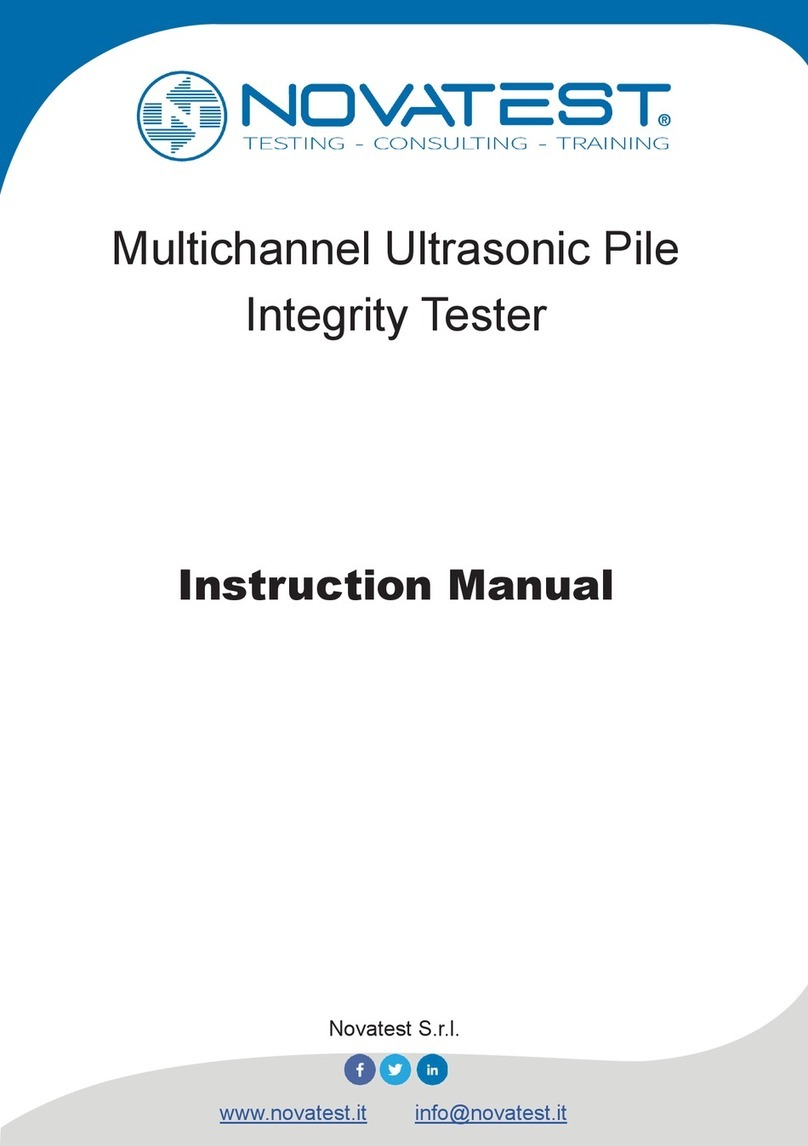
Novatest
Novatest U5700 instruction manual

Rohde & Schwarz
Rohde & Schwarz RTM3000 Series Demo guide
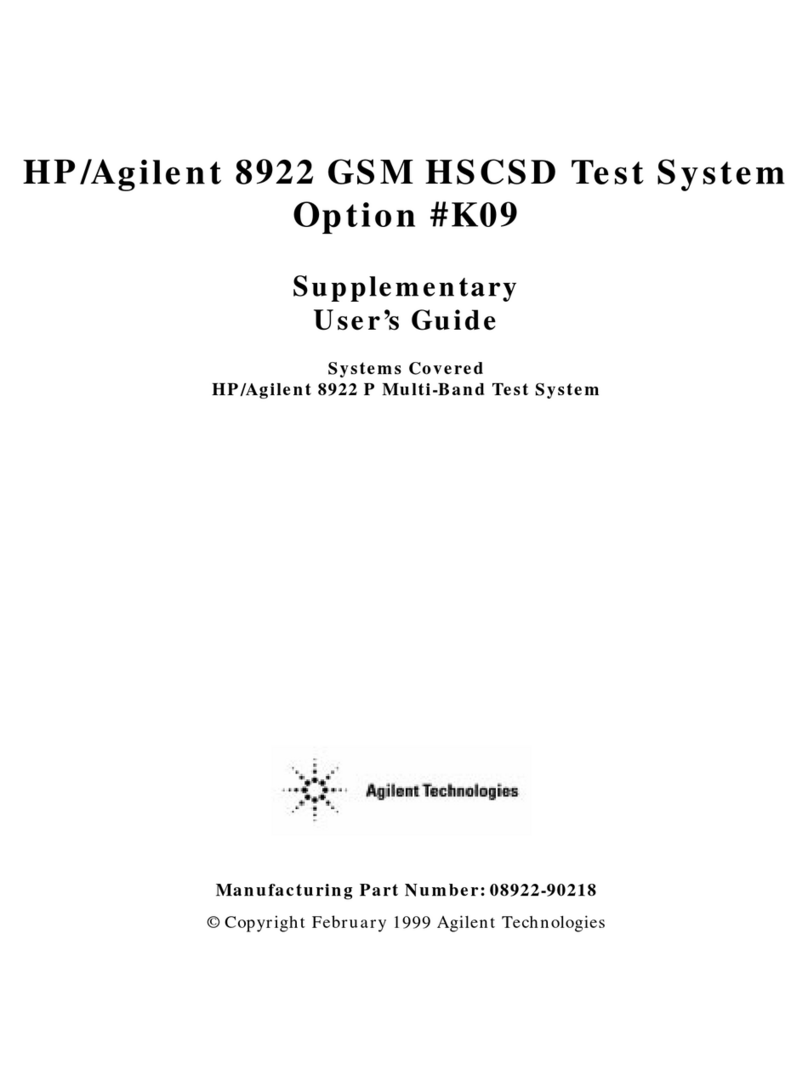
Agilent Technologies
Agilent Technologies 8922 Supplementary User's Guide
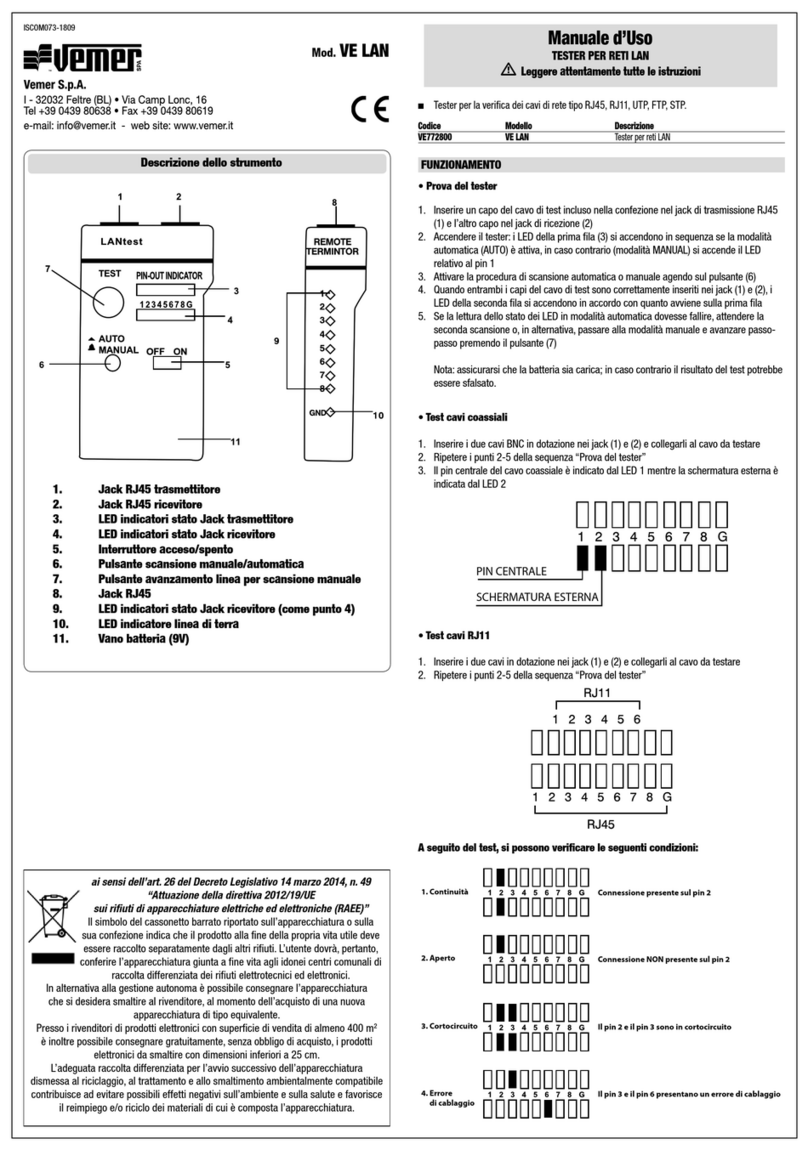
Vemer
Vemer Ve LAN user manual

Hioki
Hioki 3154 instruction manual

